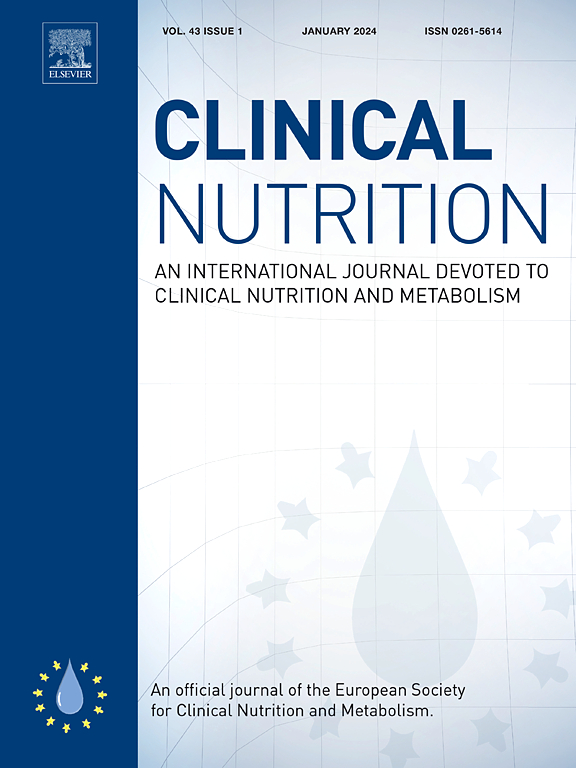The potential of body mass index-adjusted calf circumference as a proxy for low muscle mass in the global leadership initiative on malnutrition criteria
IF 6.6
2区 医学
Q1 NUTRITION & DIETETICS
引用次数: 0
Abstract
Background & aims
Reduced muscle mass is one of the diagnostic components for Global Leadership Initiative on Malnutrition (GLIM), with various assessment methods proposed. Calf circumference (CC), a representative anthropometric marker of skeletal muscle mass, is now recommended to adjustment based on body mass index (BMI). This study aimed to evaluate the validity and efficacy of BMI-adjusted CC in very older adults, compared with other methods of assessing muscle mass.
Methods
This prospective cohort study included 284 patients aged 65 years and older who were admitted to the Department of Geriatric Medicine at the National Center for Geriatrics and Gerontology Hospital. Health indicators, including nutritional status, were assessed upon admission. Three months after discharge, a telephone survey was conducted to assess patients’ living conditions and survival status. Skeletal muscle mass was estimated using a dual-energy X-ray absorptiometry (DXA); moreover, anthropometric measurements (unadjusted and BMI-adjusted CC) were used as markers of muscle mass. Logistic regression analysis was performed to examine the association between mortality and GLIM-based malnutrition, using each muscle mass assessment method.
Results
The mean age of the patients was 86.2 ± 6.2 years, and 60.9 % were women. The prevalence of GLIM-based malnutrition ranged from 55.3 % to 58.8 % across the three methods used to assess reduced muscle mass. Three months after discharge, 244 patients were followed up, of whom 29 (11.9 %) died. Multivariate logistic regression analysis, adjusted for age, sex, and comorbidities, showed that all methods significantly predicted 3-month mortality, with odds ratios of 5.67, 5.44, and 4.90 for unadjusted CC, BMI-adjusted CC, and appendicular skeletal muscle mass index using DXA, respectively. The prevalence and survival-predictive ability were similar across all methods.
Conclusion
GLIM-based malnutrition, diagnosed using different methods for assessing muscle mass, similarly predicted 3-month mortality in patients admitted to an acute geriatric ward. These results suggest that BMI-adjusted CC are sufficient alternatives when technical measurements such as DXA are not feasible.
体重指数调整后的小腿围度作为全球营养不良领导倡议标准中低肌肉质量替代指标的潜力
背景& 目的肌肉质量下降是全球领导力营养不良倡议(GLIM)的诊断内容之一,并提出了各种评估方法。小腿围(CC)是骨骼肌质量的代表性人体测量指标,目前建议根据体重指数(BMI)进行调整。这项前瞻性队列研究纳入了 284 名年龄在 65 岁及以上、入住国家老年医学和老年病学中心医院老年医学部的患者。入院时对包括营养状况在内的健康指标进行了评估。出院三个月后,对患者的生活条件和生存状况进行了电话调查。骨骼肌质量是通过双能 X 射线吸收测定法(DXA)估算出来的;此外,人体测量(未调整和 BMI 调整后的 CC)也被用作肌肉质量的标记。采用每种肌肉质量评估方法,对死亡率和基于 GLIM 的营养不良之间的关系进行了逻辑回归分析。 结果患者的平均年龄为(86.2 ± 6.2)岁,60.9%为女性。在三种评估肌肉质量减少的方法中,基于 GLIM 的营养不良发生率从 55.3% 到 58.8% 不等。出院三个月后,对 244 名患者进行了随访,其中 29 人(11.9%)死亡。经年龄、性别和合并症调整后的多变量逻辑回归分析表明,所有方法都能显著预测 3 个月的死亡率,未调整的 CC、BMI 调整的 CC 和使用 DXA 的附属骨骼肌质量指数的几率比分别为 5.67、5.44 和 4.90。结论使用不同的肌肉质量评估方法诊断出的基于 GLIM 的营养不良同样可以预测入住老年病急症病房的患者 3 个月的死亡率。这些结果表明,在无法进行 DXA 等技术测量的情况下,BMI 调整后的 CC 足以作为替代方法。
本文章由计算机程序翻译,如有差异,请以英文原文为准。
求助全文
约1分钟内获得全文
求助全文
来源期刊

Clinical nutrition
医学-营养学
CiteScore
14.10
自引率
6.30%
发文量
356
审稿时长
28 days
期刊介绍:
Clinical Nutrition, the official journal of ESPEN, The European Society for Clinical Nutrition and Metabolism, is an international journal providing essential scientific information on nutritional and metabolic care and the relationship between nutrition and disease both in the setting of basic science and clinical practice. Published bi-monthly, each issue combines original articles and reviews providing an invaluable reference for any specialist concerned with these fields.
 求助内容:
求助内容: 应助结果提醒方式:
应助结果提醒方式:


